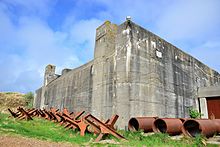Tirpitz position
The Tirpitz position is a bunker facility near Blåvand near the Danish town of Esbjerg . Construction began during World War II but was never completed. The position is named after the German Grand Admiral of the former Imperial Navy Alfred von Tirpitz (1849–1930).
history
In July 1944, the German occupation forces under General Field Marshal Erwin Rommel began building the bunker complex, which included the largest bunkers in Rommel's entire coastal defense. The plant should be completed by September 1945.
The Tirpitz position was to cover the sea area in front of the entrance to Esbjerg with four 38 cm rapid loading cannons. The two artillery bunkers each consisted of 2000 m³ of concrete , the entire position of 6000 m³.
The plan for the Tirpitz position provided for numerous bunkers:
- two cannon bunkers for 38 cm guns on double mounts
- two ammunition bunkers
- a fire control bunker
- two train bunkers with anti-aircraft gun
- six crew bunkers
- two heavy flak bunkers
Most of the planned bunkers were not built until the liberation of Denmark from the German occupation; the shell of the two gun bunkers was largely completed.
Cannon bunker:
- Base area: 25.3 m × 22.6 m
- Height: 10.6 m
- External walls and ceiling: 3.5 m
- Inner walls: 1.0–1.5 m
- Floor: 1.2 m
Guns:
- 38 cm rapid loading cannon C / 34 on double mount with tank turret
- Length: 19.63 m
- Weight: 111 tons
- Side straightening angle: 360 °
- Elevation angle: −5 ½ ° to + 30 °
- Firing range: explosive tank shell (800 kg) = 42.1 km; Tank shell (495 kg) = 54.9 km
- Rate of fire: 2 rounds per tube / minute
The pipes were four of the six 38 cm pipes from the damaged and decommissioned battleship Gneisenau , which they received after converting three 28 cm triplet towers to three 38 cm towers (in a double -pipe arrangement) should. However, the Tirpitz position was never completed. At the time of the German surrender , the four cannons were on heavy trucks in Guldager station between Varde and Esbjerg, as the bridges in Varde were not designed for the 110-ton wagons.
After completion, all bunkers should be largely embedded in sand and planted for camouflage and protection. Underground passages or splinter protection trenches were supposed to create the connection between the bunkers. A narrow-gauge railway was provided for transporting the projectiles.
The position today
After the war, the Allies inspected and cordoned off the facilities and later handed them over to the Danish government. The Danish army considered using it (e.g. ammunition storage, etc.), but then gave up the idea. The facilities were blown up, except for the two large bunkers, which were intended for the artillery equipment. The northern bunker 1 has been preserved and in the condition of the construction phase at that time. Bunker 2 was expanded as a museum for the Atlantic Wall and is still in use today. Only a partial blast was carried out to drain the filled bunker. The round shaft for the cannon tower was provided with a transparent plastic dome. Exhibitions and two film rooms (Danish and German dubbing) complete the bunker, which is otherwise in its original condition. The Tirpitz Museum was completely renovated and officially inaugurated by Crown Prince Frederik on June 29, 2017. There are exhibitions on the history of the Danish west coast, the effects of the Second World War on the region and amber . An underground tunnel also leads into the old Tirpitz bunker with a fourth exhibition on the history of the Atlantic Wall.
Between bunkers 1 and 2, only some concrete ruins can be seen.
Three of the four cannon barrels were scrapped in the 1960s. The last one was transported by train to Copenhagen , where it was exhibited as the world's largest cannon barrel in the Royal Danish Armory Museum. In 2005 it was taken to the Hanstholm Bunker Museum and can be viewed there.
literature
- Museum information sheet, Blavandshuk Local History Archive, 2014
Web links
- Museum website (in Danish).
- Complete guide of the museum (in German)
Individual evidence
- ↑ kongehuset.dk: Indvielse af Tirpitz-Museet (June 29, 2017) , Danish, accessed on July 7, 2017
- ↑ site Varde Museum (vardemuseerne.dk), Danish , accessed on July 15, 2017
Coordinates: 55 ° 33 ′ 1.2 ″ N , 8 ° 10 ′ 19.9 ″ E



